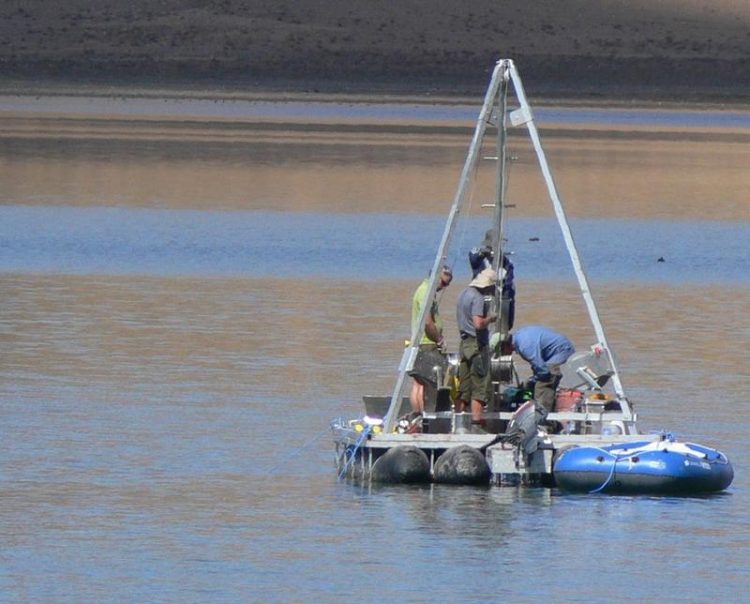The origins of Europe’s climate

The international research team during the geoscientific survey at Lake Sidi Ali in the Moroccan Middle Atlas. Photo by Physical Geography working group, Leipzig University
Influencing current climate and weather events in Northwest Africa and Europe, this wide-ranging phenomenon in the North Atlantic describes fluctuations in the difference of atmospheric pressure between the Icelandic Low to the north and the Azores High to the south. The fluctuations of the North Atlantic Oscillation are accompanied by supra-regional changes in rainfall, especially in the western Mediterranean and northern Europe.
Although the earth has been in a warm period – the Holocene – for the last 11,700 years, the beginning of the current climate conditions in Europe seems to have come much later: the scientists identified a striking change in hydroclimatic conditions about five millennia ago, which corresponds with the establishment of climate mechanisms comparable to today’s North Atlantic Oscillation. The results have now been published in the journal Climate of the Past.
Physical geographers and geoscientists from the Universities of Leipzig, Manchester, Marrakesh and Iceland are involved in the international research project, which is funded by the German Federal Ministry of Education and Research (BMBF).
By examining core samples from Lake Sidi Ali in the Moroccan Middle Atlas, the scientists were able to trace various winter rain phases back to the beginning of the Holocene some 11,700 years ago.
“We discovered that winter rain anomalies in the western Mediterranean are chronologically in phase with subpolar North Atlantic cooling episodes,” explains Christoph Zielhofer, who collaborated closely with Anne Köhler from the Institute for Geography at Leipzig University.
In 2001, renowned geologist Gerard C. Bond established a series of nine subpolar iceberg surges during the Holocene, which he reconstructed using mineral particles of continental origin from marine core samples taken from the North Atlantic. These so-called “Bond events” represent nine large-scale North Atlantic cooling episodes.
Based on oxygen isotope levels measured in the shells of small ostracods from core material recovered from Lake Sidi Ali, Christoph Zielhofer and his team were able to reconstruct Holocene rain anomalies for the western Mediterranean.
They established a temporal link between these anomalies and the Bond events from the subpolar North Atlantic. “Our data show a noticeable synchronicity between western Mediterranean winter rain minima and ‘Bond events’ during the Early Holocene,” comments William J. Fletcher, physical geographer at the University of Manchester.
There are also clear indications of an enduring hydroclimatic change in the overall atmosphere-ocean system of the North Atlantic some 5000 years ago. At that time, supra-regional climate mechanisms began to change: in the western Mediterranean, phases of increasing winter rain coincided with iceberg surges in the subpolar North Atlantic.
Recurrent phases of increased winter rainfall in the western Mediterranean with simultaneous cooling are similar to current activity observed in the North Atlantic Oscillation, which today has a major influence on weather and climate events throughout Europe.
The striking change 5000 years ago can thus be seen as the birth of our current climate in Europe. “We assume that the abrupt shift in hydroclimate 5000 years before present was a threshold mechanism response of the European climate to a gradual change in long-term insolation,” remarks Steffen Mischke of the University of Iceland in Reykjavik.
Original title of the publication in Climate of the Past:
Western Mediterranean hydro-climatic consequences of Holocene ice-rafted debris (Bond) events, doi.org/10.5194/cp-15-463-2019
Professor Christoph Zielhofer
Institute for Geography
Phone: +49 341 97-32965
Email: zielhofer@uni-leipzig.de
Web: http://www.uni-leipzig.de/geographie
Dr William J. Fletcher
University of Manchester
Email: will.fletcher@manchester.ac.uk
Dr Steffen Mischke
University of Iceland, Reykjavik, Iceland
Email: smi@hi.is
Media Contact
More Information:
http://www.uni-leipzig.deAll latest news from the category: Earth Sciences
Earth Sciences (also referred to as Geosciences), which deals with basic issues surrounding our planet, plays a vital role in the area of energy and raw materials supply.
Earth Sciences comprises subjects such as geology, geography, geological informatics, paleontology, mineralogy, petrography, crystallography, geophysics, geodesy, glaciology, cartography, photogrammetry, meteorology and seismology, early-warning systems, earthquake research and polar research.
Newest articles

Pinpointing hydrogen isotopes in titanium hydride nanofilms
Although it is the smallest and lightest atom, hydrogen can have a big impact by infiltrating other materials and affecting their properties, such as superconductivity and metal-insulator-transitions. Now, researchers from…

A new way of entangling light and sound
For a wide variety of emerging quantum technologies, such as secure quantum communications and quantum computing, quantum entanglement is a prerequisite. Scientists at the Max-Planck-Institute for the Science of Light…

Telescope for NASA’s Roman Mission complete, delivered to Goddard
NASA’s Nancy Grace Roman Space Telescope is one giant step closer to unlocking the mysteries of the universe. The mission has now received its final major delivery: the Optical Telescope…



